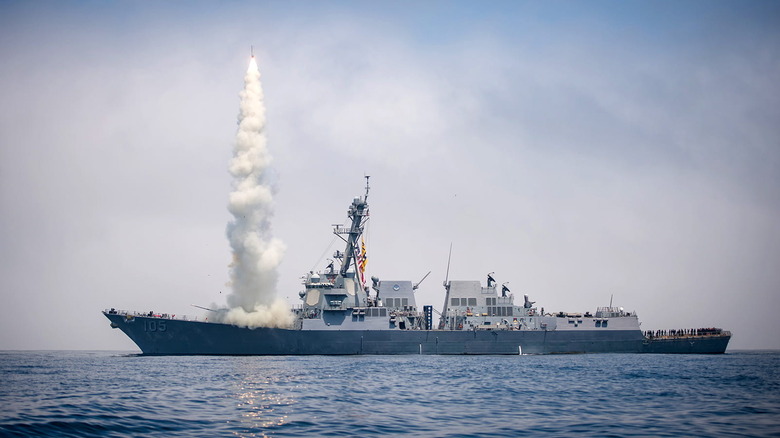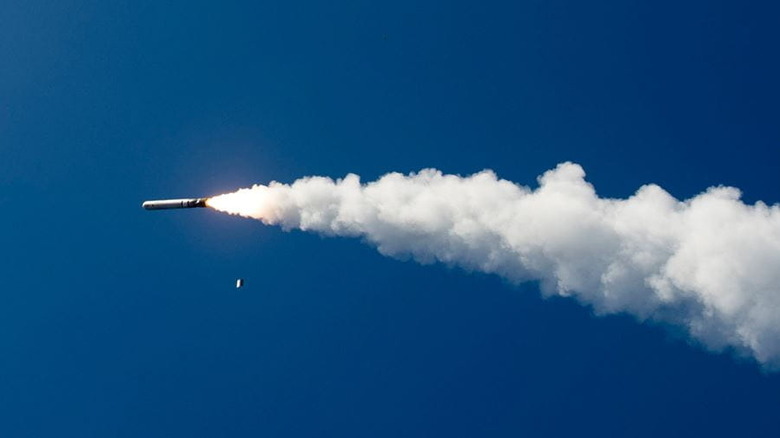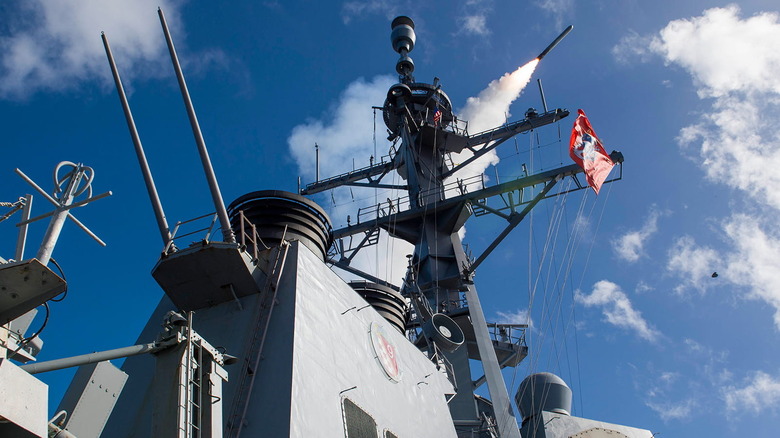Why Tomahawk Missiles Use Silver (And How Much They Contain)
It seems like all we hear about these days is rare earth minerals and precious metals, all of which find their way into modern electronics to power advanced tech. It's all highly valuable stuff, waiting to be unearthed at mining sites, where it eventually gets processed and sold. Some of it ends up in the catalytic converters of cars, while other metals like silver and gold are often found on people's hands and ears. But these metals also power electronics. Missiles are no different. The Tomahawk Land Attack Missile (TLAM), made by Raytheon, is a long-range cruise missile for land attack, typically launched from U.S. and British vessels. Each missile contains a warhead, engine, fuel tank, guidance system, booster rocket, and of course, silver — up to 500 ounces, according to estimates.
Silver has the highest thermal and electrical conductivity out of any element, where it is often used in the production of solar panels, batteries, circuit boards, and touch screens, with great corrosion resistance. It also ends up in missiles. The actual mechanistic and specific integration of silver into these weapons, like most currently-in-use military tech, remains secret. However, silver is known to be a key and indispensable component of military weaponry, communication networks, and defense hardware. But why do Tomahawk missiles contain this sought-after metal, and how much silver do they contain?
Where silver shines in the Tomahawk missile
A Tomahawk missile can be precisely guided to hit targets 1,000 miles away, available in two versions: the Block IV and Block V. The former uses a data link system that allows targets to be changed mid-flight, in addition to loitering for hours before changing course instantaneously on demand. The latter version is a 2020 update, extending its lifespan to 15 years and modernizing navigations systems which allow it to hit moving targets at sea, and more diverse land targets. These missiles are able to achieve such feats in part due to guidance systems, including the Inertial Guidance System (IGS), Terrain Contour Matching (TERCOM), GPS, and Digital Scene Matching Area Correlator (DSMAC), all benefiting from the inclusion of silver. For example, the DSMAC system employs a camera and image corrector to match up imagery mapped by the missile, to see how it corresponds against programmed maps. Silver is found in the electrical contacts, connectors, and circuit boards of these navigation systems.
Additionally, Tomahawk missiles use silver in their high-energy-density batteries. These silver-zinc battery cells are used by the Tomahawk's guidance controls, telemetry, tracking systems, actuator, and flight termination systems. The high energy output relative to the battery's size and weight, numerous configurations, long active and shelf life, combined with strong reliability, make them ideal. All of these integrated systems are required for Tomahawks to be maximally effective, which is of the utmost importance considering the $2 million price tag per missile.
Hundreds of ounces of silver could go into every Tomahawk
So we know why silver is used in a Tomahawk missile and how it benefits them. But just how much of this precious, expensive metal is in each one? While some news outlets and online pundits claim that each missile contains 500 ounces of silver, it is impossible to know with a great degree of certainty because, well, it's a secret. The U.S. Military would prefer to keep it that way. However, some have posited with even more precision that the figure is 480 ounces, which works out to be 30 pounds of silver. At the time of publishing, that amount would add up to $17,640 worth, per the current price per ounce of silver. Considering each missile's total cost, it is a relatively small portion of the bill, but it's a lot of silver that inevitably gets destroyed, nonetheless.
Without knowing the exact amount of silver used, we know that it ends up in, no shock here, the silver-zinc batteries. Silver also ends up being used for solder, acting as a glue to keep electrical connections on circuit boards secure — important, considering the speeds and intensity of these weapons. Silver adds up in other ways, like its use in connectors and wiring, or as insulation against extreme temperatures. While there are much larger ballistic missiles out there, which may potentially require even more silver, we at least know that the metal is an irreplaceable and imperative component in modern Tomahawks.


